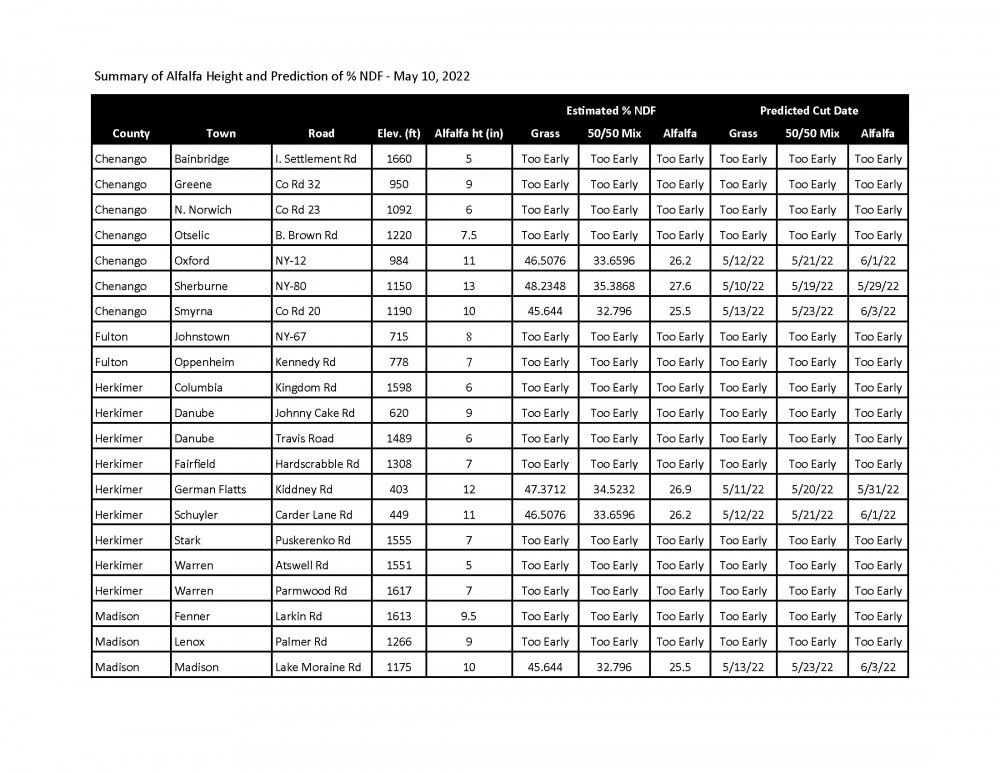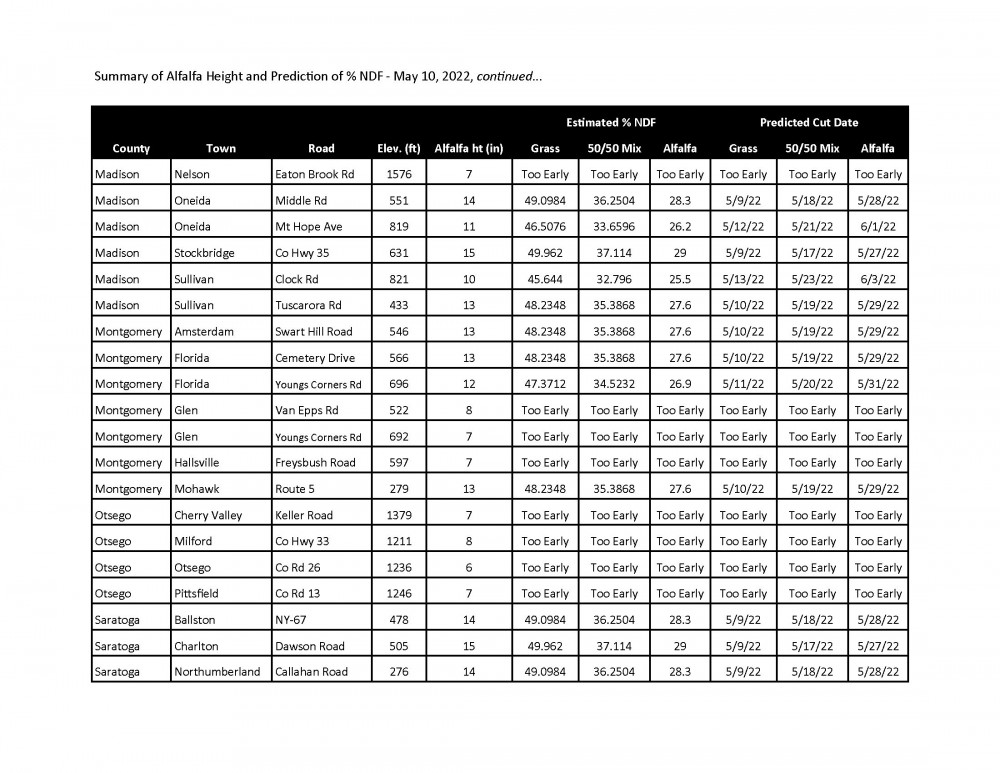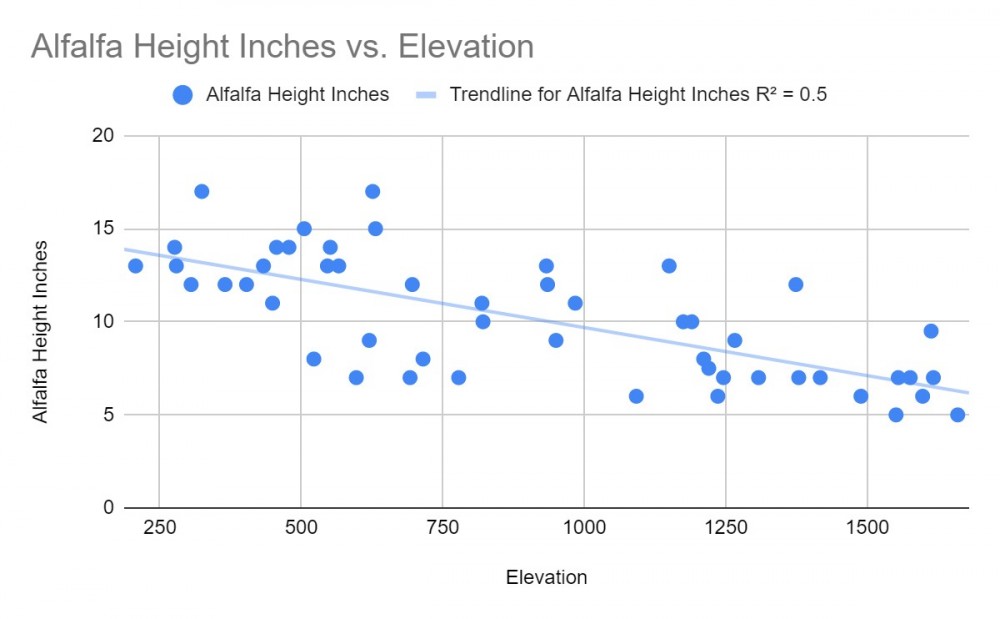1st Cutting Forage Quality Update ~ May 10, 2022
Erik Smith, Area Field Crop Specialist
Central New York Dairy and Field Crops
This is our second week of monitoring 1st cutting for quality in 2021. If you are not familiar with our procedures, we use alfalfa height to predict Neutral Detergent Fiber (NDF) for alfalfa, alfalfa/grass mixed and grass stands.
Alfalfa height has proven to be a reliable indicator of NDF values in the field. Here are numbers that are helpful when using alfalfa and grass height as an indicator of NDF content. In general:
Begin cutting 100% grass stands when nearby alfalfa is 14" tall to achieve the desired 50% NDF.
Begin cutting 50/50 alfalfa/grass stands when nearby alfalfa is 22" tall for the desired 44% NDF.
Begin cutting 100% alfalfa stands when alfalfa is 28" tall for the desired 40% NDF.
To achieve the desired NDF it is necessary to begin cutting at NDF values slightly lower than the desired value assuming some harvest and storage losses which the above alfalfa height values reflect. For example 28 inch tall alfalfa is closer to 38% NDF but you will need to start then to end up at 40% NDF.
Predicted days to cut are based on daily NDF increases for grasses of 1% point, 50/50 mixed stands of .8% points and alfalfa of .5% point. Typically, NDF increases about 0.8 to 1.2/day for grasses expecting the lower end of that range in cooler weather and the higher end in warm. Alfalfa NDF increases about 0.4 to 0.7/day again figuring the lower end of that range with cool temperatures and the higher in warm. See the following fact sheet for more details: Predicting Spring Fiber Content of Forages.
Below is this week's chart, but you can use the location and elevation as a guide to conditions that may be similar to your own. Always check your fields to verify your heights and conditions!


Things are chugging along nicely with the sunshine and warm weather! We began the season a few weeks behind last year's development, but we're now only about a week behind last year. Forages are set to make large strides in maturity through the rest of this week, so I hope folks can plant corn now (as many are).
Winter forages are entering (or already in) the boot stage, so please check on your fields' development to ensure you're able to harvest.
I've swept a few alfalfa fields and have seen no leafhoppers - only a few other insects, none of which are on our radar as pests. The few corn pheromone traps I've already set yielded no cutworm/armyworm this week either.
This week, heights are hewing closer to the trendline. The effect of elevation on alfalfa height is more pronounced this week, with alfalfa height decreasing by about an inch for every ~200 ft rise in elevation, and we may see our first mixed stands (in the lower elevations) at peak quality by this weekend! If you're projected to be at peak this weekend, check the weather report in your area - it's better to take your cutting before the rain than have to wait a day or two for it to dry afterward and miss your chance…. So get out there and check!

Upcoming Events
DEC Pesticide Applicator Exam
April 19, 2024
Morrisville, NY
New York State Fiber Conference
June 9, 2024
Bouckville, NY
Theme for this year: Quality Matters
Announcements
Cash Rent and Custom Harvest Survey
To date, there is limited information available about rental rates and fees for crop harvesting. Farms can use this valuable information for their farm business planning to help improve decision making and profitability.Farmers Can Join MeatSuite For Free!
MeatSuite.com is a free resource provided by Cornell University where NY meat farmers can create a farm profile and list their bulk (wholes, halves, quarters) and bundled (i.e. Grilling Bundle) meat products.Why should farmers join?
1. It's free and easy!
2. Connect with more local customers. In the past year the MeatSuite.com farm directory had 8,300 visits from New York consumers. Farm profiles get as many as 25 views per month from potential local customers. We also spotlight MeatSuite farms on social media and bring attention and purchases to farms through highlights and giveaways.
How do I join?
Farmers can visit https://www.meatsuite.com/farmers/ to create a free farm profile. You must list at least one product for your farm's profile to go live. You'll also have access to Cornell's free Meat Price Calculator, a helpful tool for pricing your meat to make a profit.
While you're on MeatSuite, check out the "Creating Consumer-Friendly Bulk Meats" publication on the log-in page. It has tips on how to create bulk meat products that are easier for first-time buyers to say "yes" to.
If you have any questions as you create your farm profile or products, we're here to help! Please email Matt LeRoux at mnl28@cornell.edu.




